QUESTIONS
1 Compared with plasma, aqueous humor has an increased concentration of which one of these components?
A) Protein
B) Ascorbate
C) Glucose
D) Carbon dioxide
2 Which vessel(s) provides the predominant blood supply to the surface nerve fiber layer of the optic nerve head?
A) Short posterior ciliary artery
B) Peripapillary choroidal vessels
C) Pial vessels
D) Central retinal artery
3 Which one of the following statements is false concerning the condition depicted in Figure 9-1?
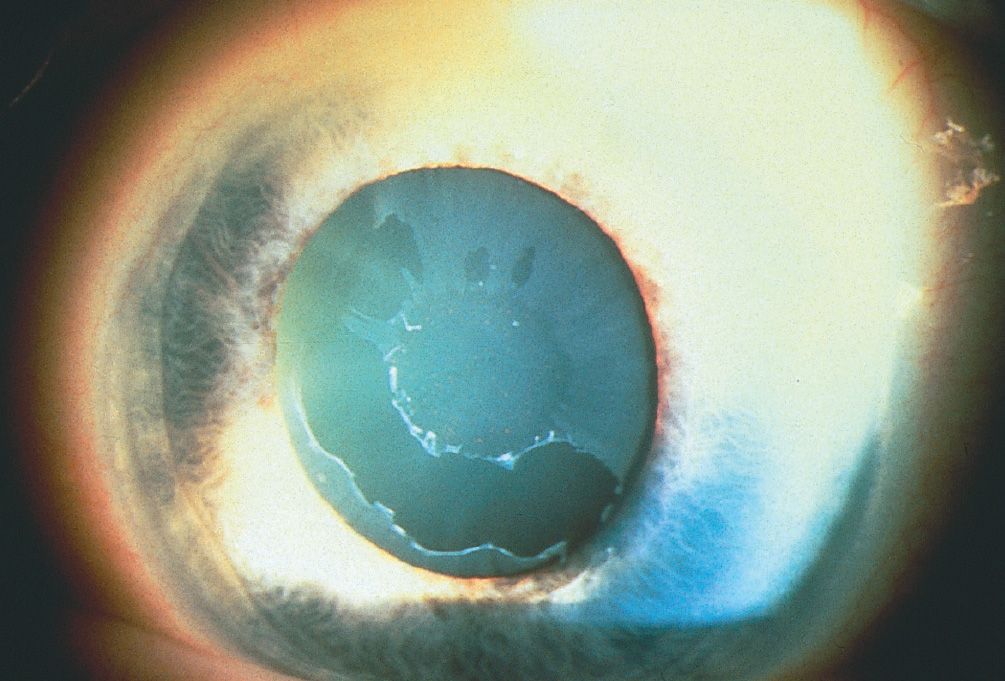
A) It has a worse prognosis than primary open-angle glaucoma (POAG).
B) It may be monocular or binocular.
C) Lens extraction alleviates the condition.
D) The intraocular pressure (IOP) is often higher than in POAG.
4 Which one of the following is not a risk factor for POAG?
A) Topical corticosteroid response
B) African American heritage
C) Positive family history
D) Diabetes mellitus
5 Which drug used during general anesthesia is associated with an increase in IOP?
A) Halothane
B) Ketamine
C) Valium
D) Phenobarbital
6 Patients with homocystinuria are at increased risk for which of the following?
A) Lens subluxation
B) Angle-closure glaucoma
C) Intravascular thrombosis with general anesthesia
D) All of the above
7 Applanation tonometry gives falsely low readings under all of the following conditions except:
A) high myopia
B) decreased central corneal thickness
C) excessive fluorescein
D) greater than 3 D of with-the-rule astigmatism
8 The reliability of visual field testing becomes suspect when pupil diameter decreases below:
A) 4 mm
B) 3 mm
C) 2 mm
D) 1 mm
9 Which test object has four times the area and the same light intensity as the Goldmann II4e target?
A) III4e
B) II2e
C) II4c
D) V2a
10 A patient is tested on the Humphrey automated perimeter. The machine projects a light at his blind spot, and the patient presses the button. What does this patient’s response represent?
A) False-positive response
B) Fixation loss
C) Short-term fluctuation
D) False-negative response
11 The visual field in Figure 9-2 is caused by a retinal lesion. Which one of the following retinal lesions corresponds to this field? (Note: the fovea is marked by “X”.)
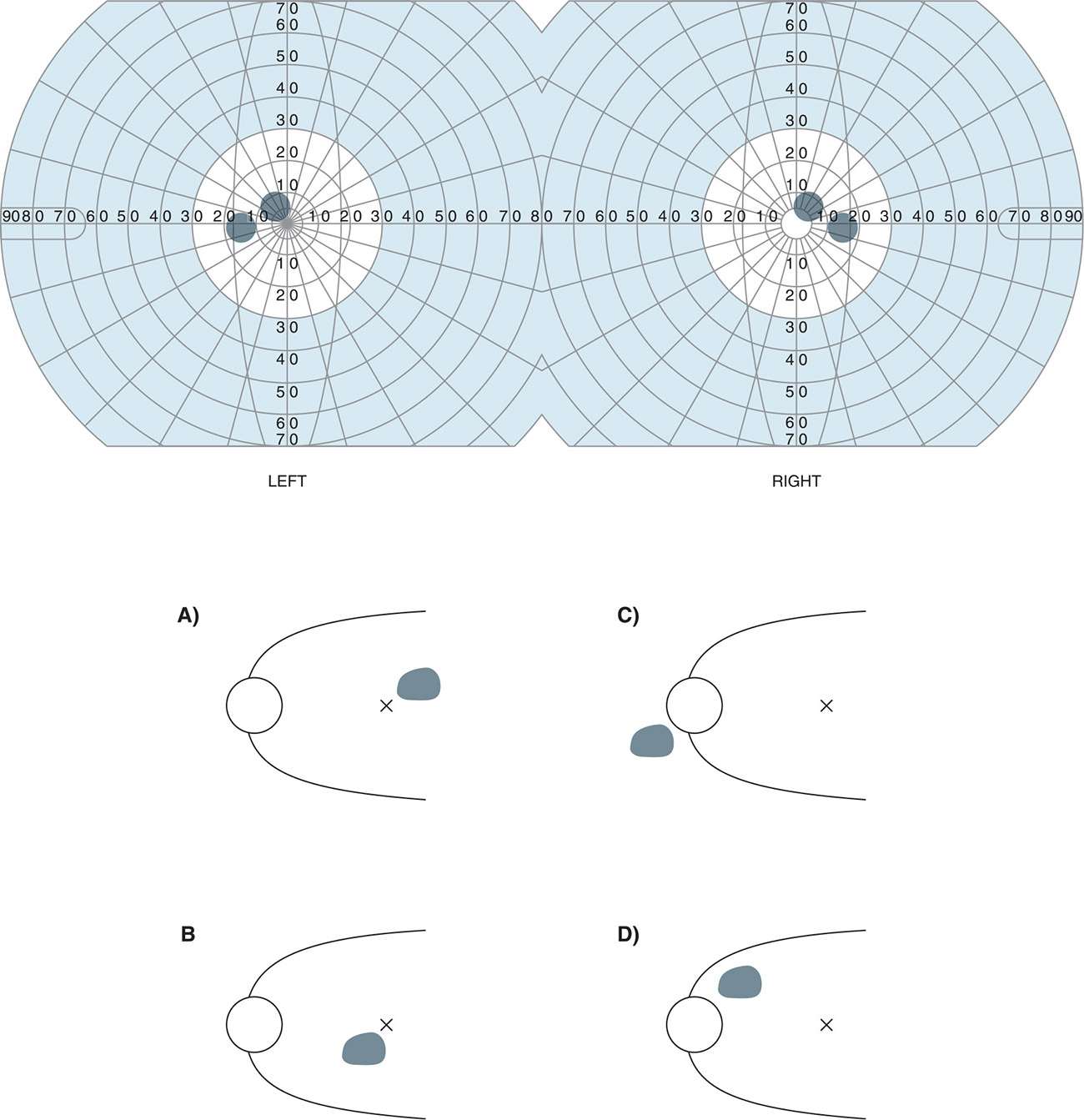
A)
B)
C)
D)
12 Which one of the following signs is most indicative of glaucomatous optic neuropathy?
A) Figure 9-3A
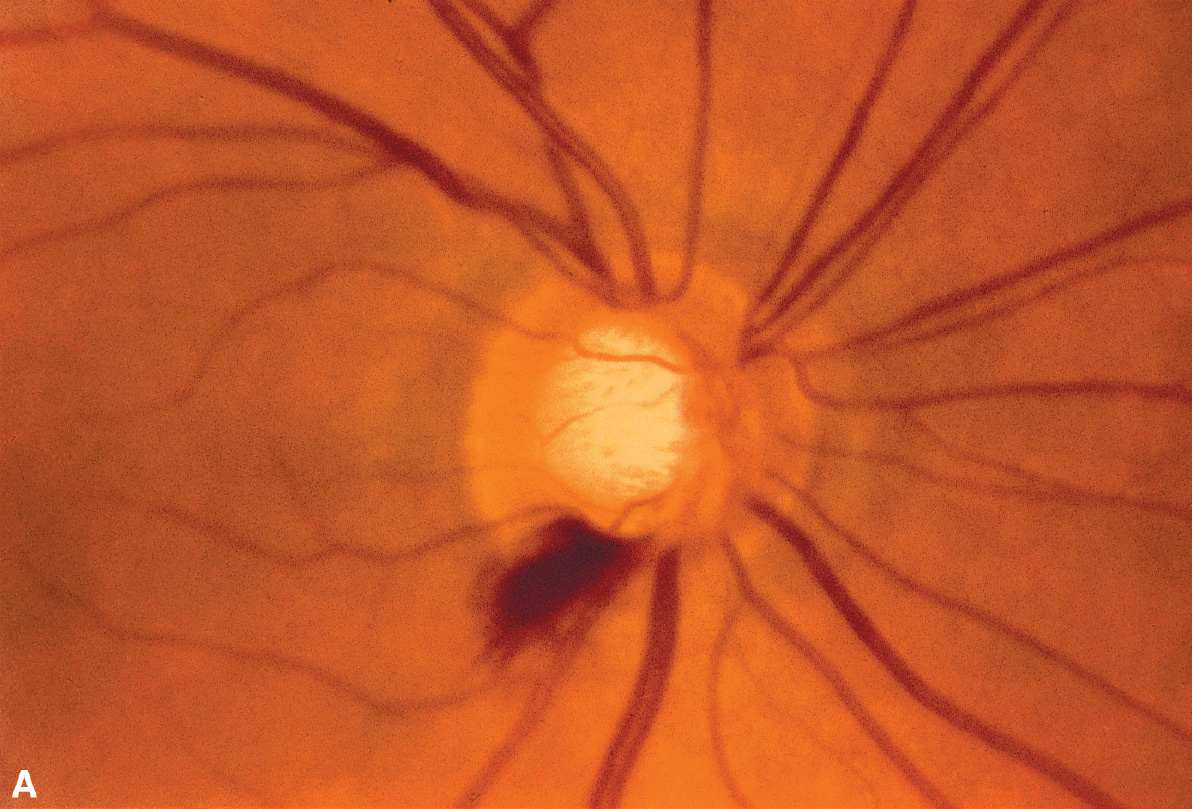
B) Figures 9-3B and C
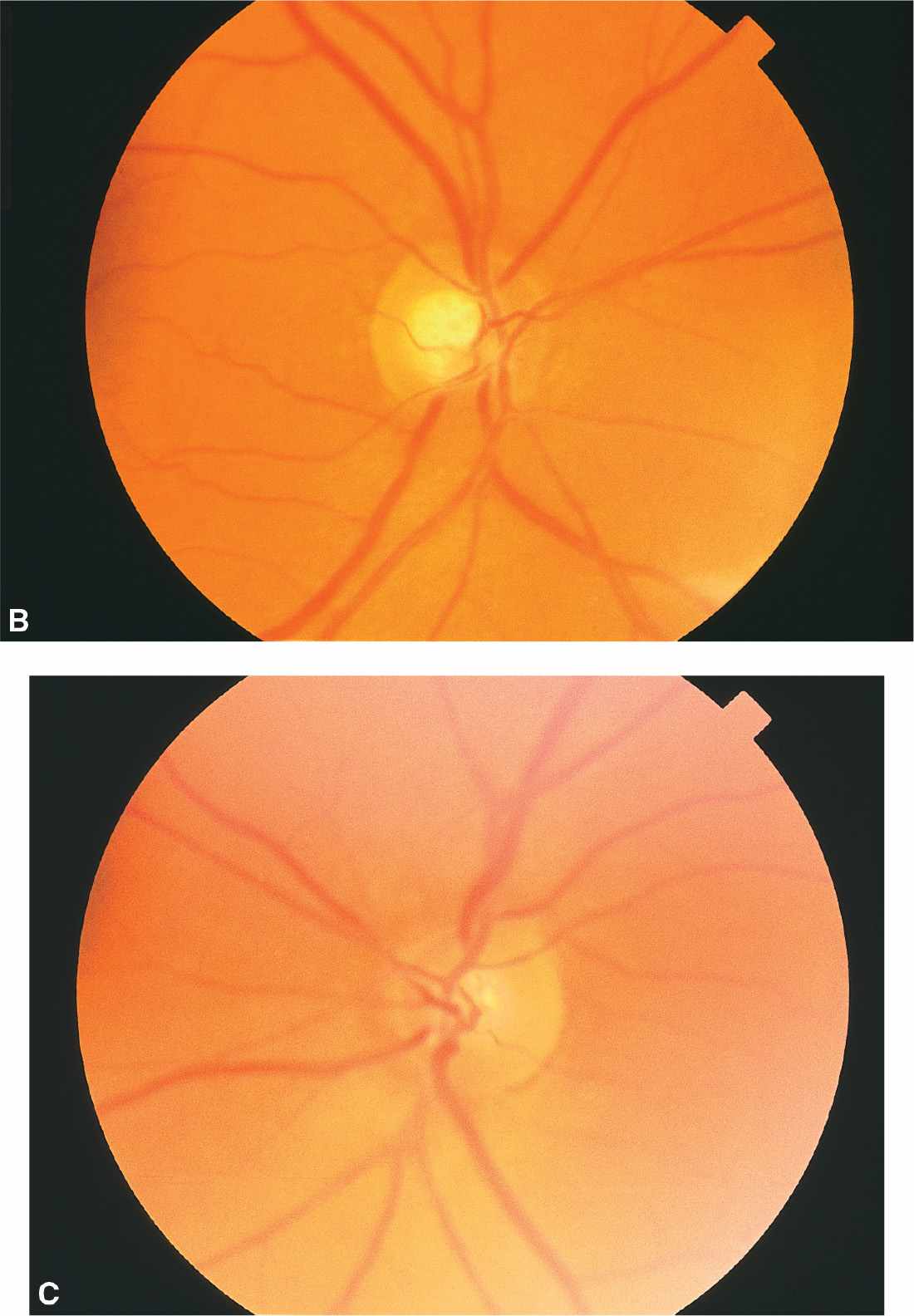
C) Figure 9-3D
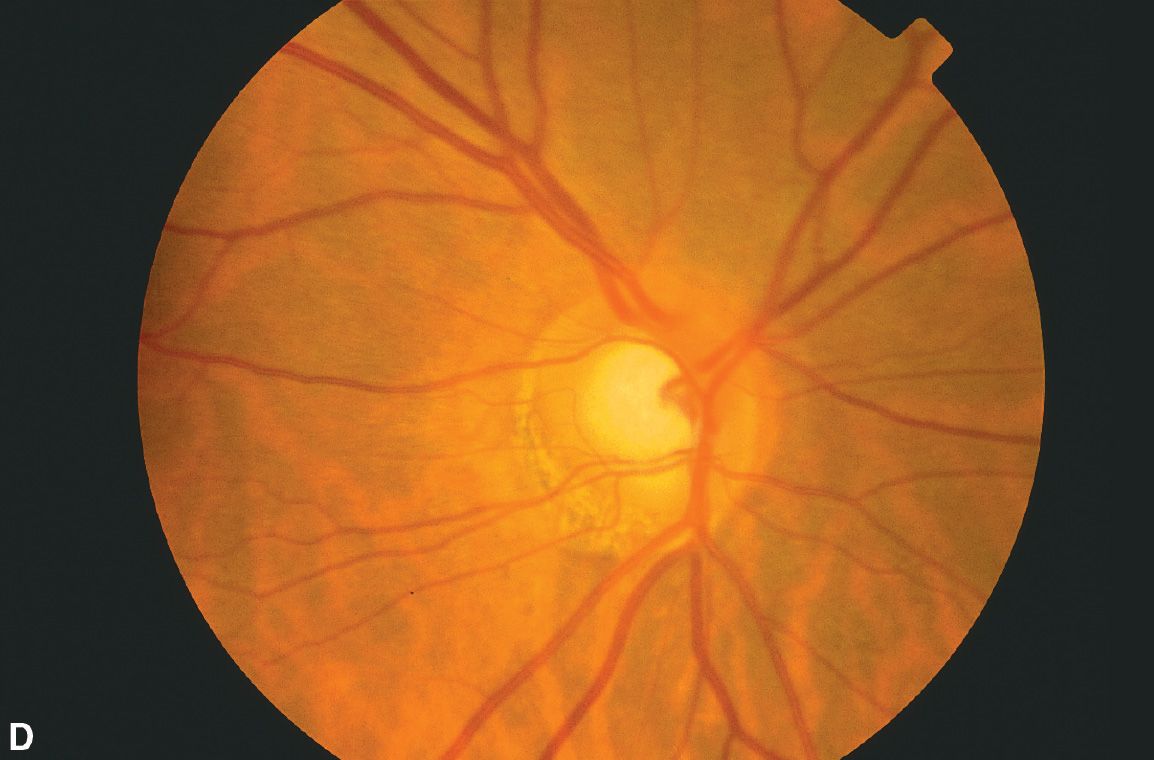
D) Figure 9-3E
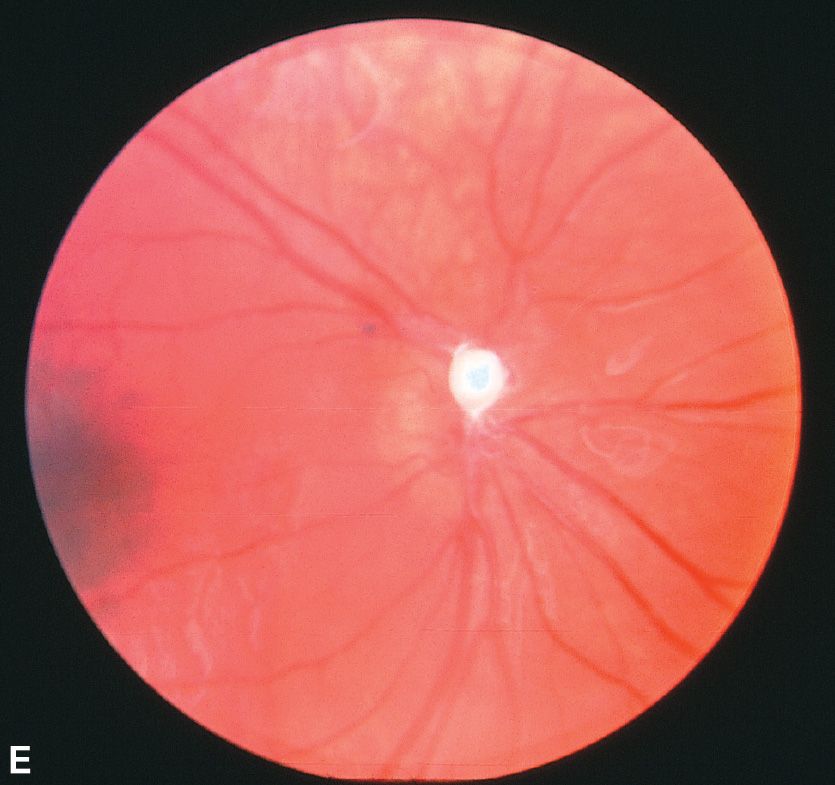
13 Based on histologic studies, what percentage of optic nerve axons may be lost before visual field changes are detected by Goldmann perimetry?
A) 10%
B) 15%
C) 25%
D) 50%
14 All of the following are well-established early signs of glaucomatous damage except:
A) vertical elongation of the cup
B) peripapillary atrophy
C) splinter hemorrhage on disc
D) nerve fiber layer loss
15 All of the following conditions are associated with increased pigmentation of the trabecular meshwork on gonioscopy except:
A) pseudoexfoliation (PXF) syndrome
B) pigment dispersion syndrome
C) prior trauma
D) all of the above
16 Iris transillumination defects are present in all of the following conditions except:
A) oculocutaneous albinism
B) PXF
C) plateau iris syndrome
D) pigment dispersion syndrome
17 All of the following contact lenses for gonioscopy are examples of indirect goniolenses except:
A) Figure 9-4A = Shields, p11b (Koeppe lens)
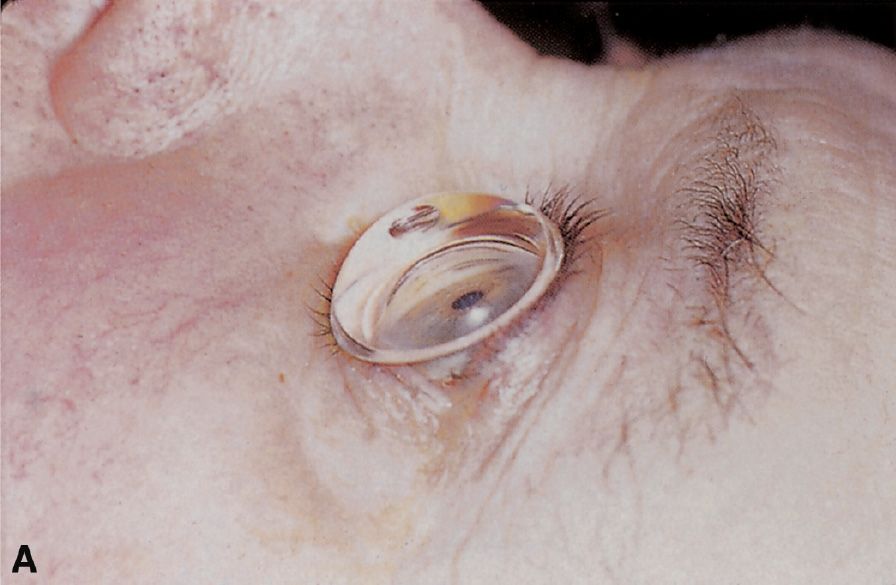
B) Figure 9-4B = Shields, p9c (Posner lens)
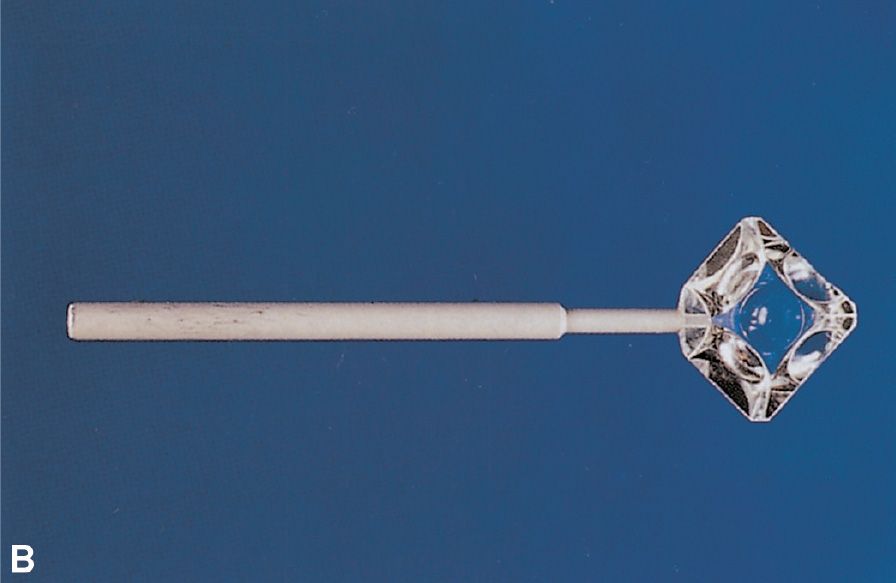
C) Figure 9-4C = Shields, p9e (Sussman lens)
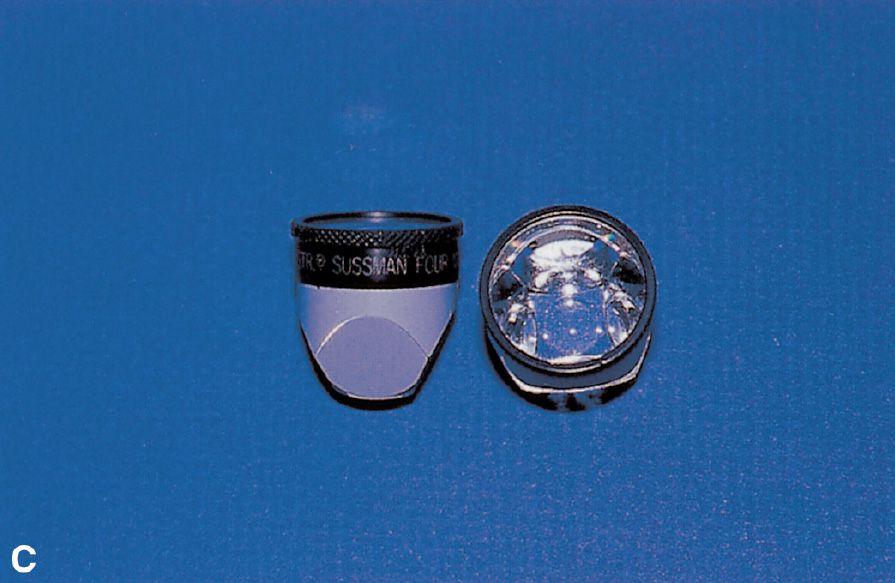
D) Figure 9-4D = Shields, p9b (Goldmann lens)
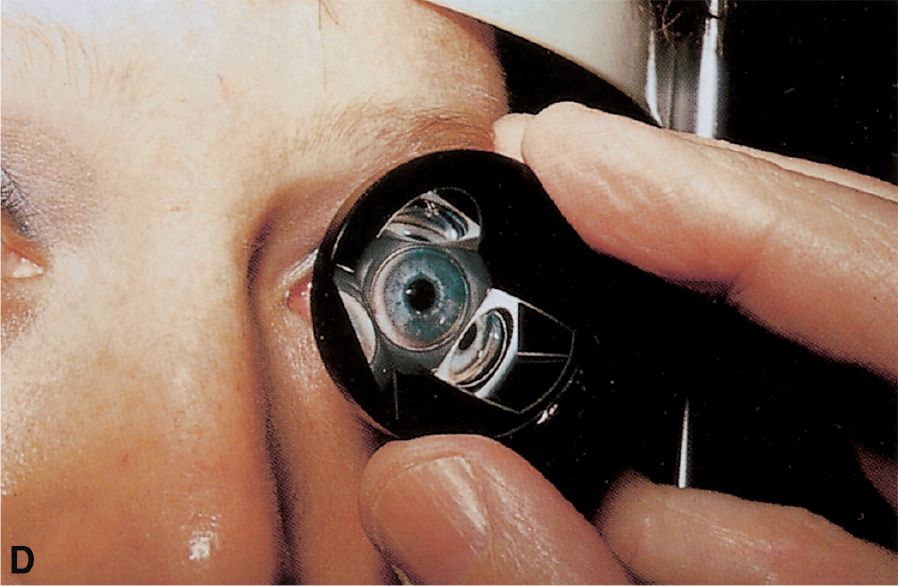
FIGURE 9-4 From Shields MB. Color Atlas of Glaucoma. Williams & Wilkins, 1998.
18 The technique least helpful in evaluating the appearance of a glaucomatous optic nerve is:
A) direct ophthalmoscopy
B) slit-lamp examination using a contact lens
C) indirect ophthalmoscopy using a 20-D lens
D) slit-lamp examination using a 90-D lens
19 Which of the following is least likely to be found in a patient with primary congenital glaucoma?
A) IOP of 23 mm Hg
B) Cup-to-disc ratio of 0.4
C) Corneal diameter of 10.0 mm
D) Open angle with high iris insertion on gonioscopy
20 With respect to uveitic glaucoma, all of the following are true except:
A) Prostaglandins (PGs) such as latanoprost should be used with caution.
B) Argon laser trabeculoplasty (ALT) may be a helpful adjunct if medications are ineffective.
C) Miotics are usually avoided.
D) Treating the intraocular inflammation is as important as lowering IOP.
21 Which one of the following has not been suggested to be a possible pathophysiologic mechanism for optic neuropathy in patients suspected of having normal-tension glaucoma (low-tension glaucoma)?
A) Nocturnal systemic hypotension
B) Vasospasm
C) Shock (hypotensive) optic neuropathy
D) Systemic hypercholesterolemia
22 Which one of the following conditions does not have the same pathogenesis of glaucoma as the others?
A) Sturge–Weber syndrome
B) Thyroid eye disease
C) Aniridia
D) Carotid-cavernous sinus fistula
23 Which surgical procedure would be initially used to manage primary congenital glaucoma with a markedly cloudy cornea?
A) Trabeculectomy with mitomycin C
B) Cyclophotocoagulation
C) Goniotomy
D) Trabeculotomy
24 Which one of the following is the most common cause of glaucoma in eyes being treated for the condition depicted in Figure 9-5?
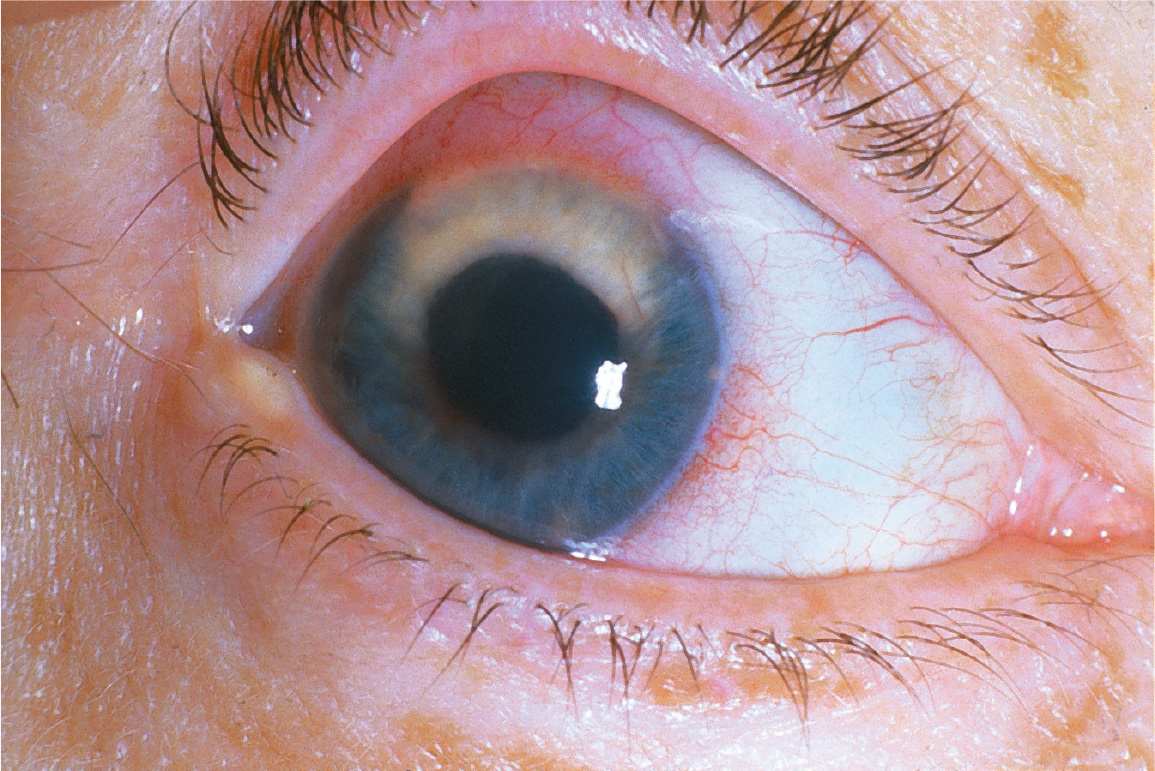
A) Tumor cells invading the angle
B) Neovascularization
C) Acute-angle closure
D) Uveitis
25 Which one of the following chemical burns is most likely to be associated with an acute elevation of IOP?
A) Chlorine bleach
B) Sulfuric acid
C) Hydrogen peroxide
D) Sodium hydroxide
26 With respect to corticosteroid glaucoma, all of the following are true except:
A) In most cases, after discontinuing the steroid, the IOP returns to normal over a few days to several weeks.
B) The rise in IOP may be delayed for years after starting the steroid.
C) Most cases are caused by long-term oral administration of steroids.
D) Patients with POAG are more susceptible to steroid-induced IOP elevations.
27 Glaucomatous optic neuropathy is associated with damage to which types of retinal cells?
A) Amacrine cells
B) Ganglion cells
C) Bipolar cells
D) Photoreceptors
28 What is the best initial therapy for malignant glaucoma?
A) Pilocarpine 2%
B) Laser iridotomy
C) Mydriatic–cycloplegic therapy
D) Lens removal
29 The condition shown in Figure 9-6 may be associated with which one of the following choices?
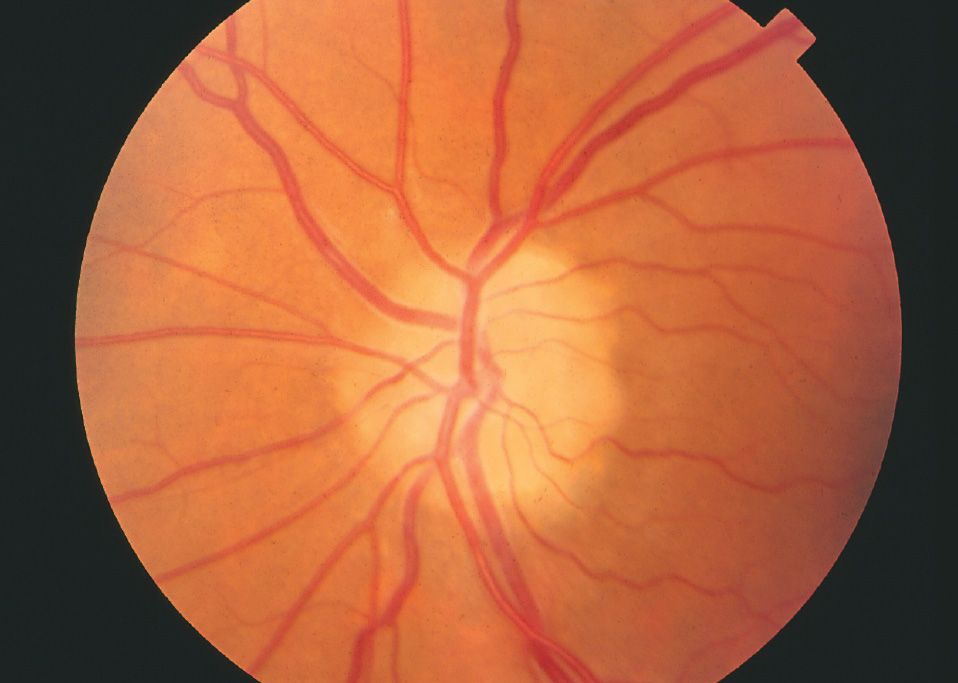
A) Visual loss
B) Papilledema
C) Autosomal recessive inheritance
D) Bilaterality in 25%
30 The most important treatment for a patient with diabetic neovascular glaucoma and good vision is:
A) atropine and topical steroids
B) aqueous suppressants
C) adequate blood glucose and blood pressure control
D) panretinal photocoagulation—consider adding anti-VEGF injections
31 Which one of the following types of glaucoma is least likely to respond to medical therapy alone?
A) Phacolytic glaucoma
B) Pigmentary glaucoma
C) Lens particle glaucoma
D) PXF
32 The eye condition least likely to be associated with aqueous misdirection syndrome is:
A) angle-closure glaucoma
B) uveitis
C) myopia
D) nanophthalmos
33 Topical β-adrenergic antagonists are known to be associated with all of the following side effects except:
A) increased plasma high-density lipoprotein cholesterol levels
B) bronchospasm and airway obstruction
C) weakened myocardial contractility
D) exercise intolerance
34 A patient who has recently undergone panretinal photocoagulation after a central retinal vein occlusion presents with corneal edema, neovascularization of the iris, and an IOP of 58 mm Hg. All of the following medications are appropriate to use except:
A) atropine
B) dorzolamide
C) apraclonidine
D) pilocarpine
35 Ocular side effects of pilocarpine include all of the following except:
A) hyperopia
B) retinal detachment (RD)
C) exacerbation of pupillary block
D) lacrimation
36 Which one of the following is not considered a possible side effect of the hyperosmotic agents?
A) Congestive heart failure
B) Subdural hemorrhage
C) Worsening of obstructive pulmonary disease
D) Mental confusion
37 What is the most likely cause of allergic conjunctivitis in a glaucoma patient? List in order of probability.
1. Latanoprost
2. Dorzolamide
3. Brimonidine
A) 1 > 2 > 3
B) 3 > 2 > 1
C) 3 > 1 > 2
D) 2 > 3 > 1
38 Which statement about carbonic anhydrase inhibitors is false?
A) Aqueous production in the eye is not significantly reduced until more than 90% of the carbonic anhydrase activity is inhibited.
B) Carbonic anhydrase inhibitors cause reduced excretion of urinary citrate or magnesium, therefore predisposing to formation of kidney stones.
C) Carbonic anhydrase inhibitors may cause idiosyncratic and transient acute myopia.
D) Metabolic acidosis is greater with oral acetazolamide than with IV injection of acetazolamide.
39 What is the most common cause of bleb failure?
A) Bleb encapsulation (Tenon cyst formation)
B) Episcleral fibrosis
C) Late bleb leak
D) Closure of the internal sclerostomy
40 Which one of the following is the most important medication to discontinue as far before glaucoma surgery as possible?
A) Pilocarpine
B) Echothiophate
C) Dipivefrin
D) Timolol
41 Medical management of bleb leaks involves all of the following except:
A) bandage soft contact lens
B) autologous blood injection
C) aqueous suppressants
D) 5-fluorouracil (5-FU)
42 Use of 5-FU following filtration surgery has been associated with all of the following except:
A) conjunctival wound leaks
B) suprachoroidal hemorrhage
C) hypotony maculopathy
D) RD
43 Apraclonidine (Iopidine), an α2-adrenergic agonist, has all of the following side effects except:
A) systemic hypotension
B) superior lid retraction
C) dry mouth
D) blanching of conjunctival vessels
44 Dorzolamide (Trusopt) lowers IOP by:
A) increasing uveoscleral outflow
B) decreasing aqueous production
C) increasing conventional (trabecular meshwork) outflow
D) decreasing episcleral venous pressure
45 What combination of medications is most effective in lowering IOP?
A) Timolol and a carbonic anhydrase inhibitor
B) Echothiophate and pilocarpine
C) Pilocarpine and dipivefrin
D) Timolol and dipivefrin
46 PG analogs lower IOP predominantly by which one of the following mechanisms?
A) Increased uveoscleral outflow
B) Enhanced aqueous outflow by stimulation of ciliary muscle contraction
C) Reduced vitreous volume
D) Reduced aqueous production
47 Which one of the following statements about SLT is true?
A) SLT achieves its effect by creating physical openings in the trabecular meshwork through which aqueous humor can pass from the anterior chamber into the canal of Schlemm
B) The chance of posttreatment IOP rise is not influenced by the number of laser burns applied in each treatment session
C) Blanching of the trabecular meshwork is the endpoint seen with each burn
D) Repeating SLT in eyes that were previously treated with ALT is acceptable
48 Laser trabeculoplasty is most likely to be helpful in an eye with which one of the following types of uncontrolled glaucoma?
A) Pigmentary glaucoma
B) Angle-recession glaucoma
C) Iridocorneal endothelial syndrome
D) Inflammatory glaucoma
49 Complications of ALT include all of the following except:
A) iritis with posterior synechiae
B) postoperative IOP spike
C) synechial angle closure
D) cataract formation
50 Which are the most appropriate laser settings for ALT?
A) Spot size: 50 µm, duration: 0.1 seconds, energy: 700 mW
B) Spot size: 50 µm, duration: 0.5 seconds, energy: 500 mW
C) Spot size: 500 µm, duration: 0.1 seconds, energy: 200 mW
D) Spot size: 500 µm, duration: 0.5 seconds, energy: 800 mW
51 The advantages of selective laser trabeculoplasty (SLT) over ALT include all of the following except:
A) SLT is more effective at lowering IOP.
B) SLT uses a potentially repeatable laser.
C) SLT selectively targets pigmented TM cells.
D) general structure of TM intact post-SLT.
52 In which condition would a laser peripheral iridectomy not be indicated?
A) Iris bombé
B) Neovascular glaucoma
C) Acute angle-closure glaucoma
D) Prophylaxis in an eye with narrow angles
53 Compared with the argon laser, the Nd:YAG laser is associated with which one of the following with respect to iridotomies?
A) Late closure of the iridotomy
B) Fewer total applications
C) Less frequent bleeding with application
D) More extensive histologic damage to the treatment site
54 In contrast to trabeculectomy without mitomycin, the use of mitomycin intraoperatively during trabeculectomy may be associated with:
A) lower surgical success rate
B) higher long-term risk of endophthalmitis
C) higher risk of RD
D) more inflammation and a more vascular-appearing bleb
55 Which one of the following procedures has the highest incidence of hypotony?
A) Full-thickness sclerectomy
B) Trabeculectomy with mitomycin C
C) Seton
D) Trabeculectomy with 5-FU
56 The adjunctive use of antifibrotic agents in trabeculectomy is indicated in all of the following situations except:
A) previously failed filtering surgery
B) young myopic patients
C) aphakic/pseudophakic patients
D) neovascular glaucoma
57 The following are true about the drugs used to modulate wound healing post glaucoma surgery, except:
A) BAPN (β-aminoproprionitrile), an inhibitor of lysyl oxidase, blocks collagen cross-linking.
B) 5-FU inhibits fibroblast proliferation by acting selectively on the S phase of the cell cycle.
C) Mitomycin C is an alkylating agent that decreases DNA synthesis by causing DNA cross-linking.
D) Colchicine acts by inhibiting fibroblast migration and proliferation.
58 Which of the following is a theoretical advantage of nonpenetrating glaucoma surgery (nonpenetrating deep sclerectomy/viscocanalostomy)?
A) Lower incidence of postoperative complications
B) Technically easier
C) Better IOP reduction when compared to standard trabeculectomy
D) None of the above
QUESTIONS 59–61 A 34-year-old lawyer is struck in the eye by a golf ball launched by an ophthalmologist. The ophthalmologist rushes the lawyer to his office and examines his eye. A 20% hyphema is present in the anterior chamber. No rupture of the globe is present.
59 The traumatized eye is at risk for developing all of the following types of glaucoma except:
A) angle-closure glaucoma
B) open-angle glaucoma
C) angle-recession glaucoma
D) phacolytic glaucoma
60 Because the IOP is elevated in the traumatized eye, proper management of the hyphema could include all of the following except:
A) corticosteroids
Stay updated, free articles. Join our Telegram channel

Full access? Get Clinical Tree


